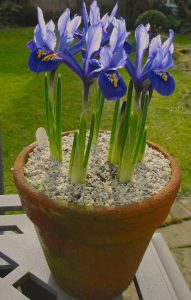Gardening year at an end? Melcourt technical director Catherine Dawson shows you there’s still plenty of garden jobs to dig into this December
Winter approaches. A season of calm in the garden. A time to put the flower beds to bed and batten down the hatches. But when the weather is mild and you have time on your hands, you might not be ready to hang up your gardening gloves! The good news is, there are many small gardening jobs that you can do right now. And your efforts today will start to bloom next year.
- Get your bulbs in
It’s not too late to plant bulbs, either in the ground or in pots. The manuals say ‘as soon as you can’ for daffs and ‘not until November’ for tulips. But it’s no problem if you missed these windows. Look for remaindered packs of bulbs in garden centres and DIY stores – and get planting.
For real impact, I like to put one variety in a pot, like these Iris reticulata. I plant 10 bulbs in a 5 inch pot of SylvaGrow Multi-Purpose compost, around 2 inches deep. Melcourt’s Coarse Grit gives a lovely finish. By late February you will be enjoying glorious, blooming mini-irises – not bad for a few minutes work in darkest December!
For indoors, why not plant an Amaryllis? Is there anything so full of potential than these large, already-rooting bulbs. Mine arrived just recently from Sarah Raven.
The following video is a guide on planting Amaryllis:

I’ll pot up in SylvaGrow Multi-Purpose compost, in a pretty 10-inch terracotta pot. I leave the top third of the bulb showing and will keep it in a warm sunny spot inside. Just take care not to overwater. They make beautiful gifts too – and what could be easier or nicer to give or receive?

- Sow winter salads
The first joyful sight of emerging seedlings can be yours year-round. All you need is a sunny windowsill and some good compost. I love our SylvaGrow with added John Innes for seed sowing. The loam element helps to achieve that all-important connection between seed and compost, making success easy.
Choose winter salad seed mixtures or leafy herbs such as basil or coriander. As compost manufacturers, we carry out growing trials throughout the year and frequently don’t have time to wait for the optimum season. We’ve learnt that although some seed packet date recommendations shouldn’t be messed with, others can be loosely applied. Many salad leaves fall into this category. If in doubt, give it a go, keep notes so you build your knowledge.
My top tip for successful sowing is this; once you have filled the seed tray or pot with compost, gently tamp down to compress it slightly. This reduces the air spaces and allows more moisture to be held in that all-important zone around the seed.
Lightly water this nice, evenly flat surface and then sow the seeds. Cover lightly with more compost. You can follow the seed packet instructions on this – but a good general rule is as much depth as the seed is in diameter. Very lightly water again and place on your lightest windowsill.
As germination may be slower at this time of year, I like to add a layer of cling film to keep the moisture in. However, I remove this as soon as the seedlings emerge.

- Propagate herbs
You can grow new herbs simply by putting a stem of basil or mint from a supermarket potted herb into a jar of water. Keep it warm on your windowsill and within days you will see roots emerging. After a couple of weeks, you will have a nice bunch of roots at the base. Pot them up in some SylvaGrow Organic and once established, pinch out the tops for nice bushy plants. Keep on your sunniest, warmest windowsill and look forward to enjoying the intense flavour of summer in winter!
- Lift or leave your tubers?
If your dahlias or cannas have succumbed to the recent frosts, now is the time to either lift them for winter storage or leave them in place. If you live in the south and have light soil (which doesn’t get too wet in the winter), there is every chance these tender plants will survive. In fact, they may even thrive due to the lack of root disturbance. But to be sure, protect the vulnerable tops – just below the soil surface – and apply a good layer of mulch.
Ideally use a mulch that doesn’t hold too much water. This could be a use for the coarser element of your garden compost. I like to use our SylvaBark Pine Bark Flakes – pure pine chunks, free draining and long lasting. They’re very attractive as well as doing an excellent insulation job.

Catherine will be sharing more tips and advice on our blog over the coming months. Share your SylvaGrow photos and gardening projects via our social media channels @sylvagrow on Facebook and Instagram.



